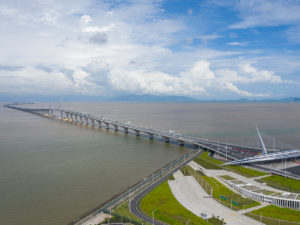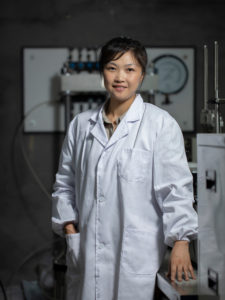The Hong Kong-Zhuhai-Macao (HZM) Bridge connects the three major cities located in the Pearl River Delta in China. Designed for a service life of 120 years, the bridge is the world’s longest sea-crossing bridge-cum-tunnel. Its maintenance, repair and operations are complicated tasks that present an enormous challenge to all three cities. At the University of Macau (UM), researchers rise to this challenge by carrying out joint research projects with other universities, research institutes, companies, and organisations, in order to realise smart maintenance, repair and operations of the HZM Bridge.
Sensors for Cross-Sea Infrastructure Monitoring
Two of these projects are under the National Key Research and Development Programme and the Guangdong Provincial Key Research and Development Programme, respectively. The national-level project concerns the applications of smart technologies in the HZM Bridge’s operation and maintenance, while the provincial-level project investigates smart safety monitoring and emergency control for sea-crossing projects. Most members of the UM team are also members of UM’s State Key Laboratory of Internet of Things for Smart City (the lab).
The UM team is headed by Wanhuan Zhou, Hannah, who is an Associate Professor and the head of the Department of Civil and Environmental Engineering of the Faculty of Science and Technology. She is also the interim head of UM’s Centre for Regional Oceans. According to Prof Zhou, the two research projects aim to create a digital version of the HZM Bridge, which involves massive data collection and analysis.
Geotechnical disaster prevention is Prof Zhou’s main research area. According to her, the structure of the HZM Bridge can be affected by events such as typhoons, earthquakes, fires, sea waves, soil movement in the seabed, and even vessel strikes. She says, ‘It is important to consistently monitor the different areas of the cross-sea infrastructure and collect data so we can effectively determine when and how to maintain and repair it.’ Monitoring is also vital to developing precautionary measures. For instance, data collected during previous typhoons are very useful. When a new typhoon is coming, such data can serve as a reference for driving advisories or traffic restrictions.
The 55-km HZM Bridge is far more than a conventional bridge. It in fact consists of a 22.9-km main crossing, western and eastern artificial islands comprising a total area of 200,000 square metres, a 6.7-km immersed tunnel, and many other components. The megastructure set many world records: It is the longest sea bridge, with the longest immersed tunnel, as well as many other advanced engineering features. At every stage of the construction, engineers had to overcome enormous challenges resulting from complex geological structures, a harsh construction environment, and the need to comply with high technical and environmental standards.
It is impossible to rely upon only human oversight for the bridge’s long-term safety, operation and maintenance, hence the need for a massive amount of smart sensors. At UM, Prof Zhou and other lab members are developing different types of sensors, some of which are made of optical fibres. She explains, ‘Optical fibres can transmit data and measure factors such as changes in temperature and strain. These data reflect how much a structure is deformed under force. Fibre optic sensors are particularly ideal for a humid environment such as the tunnel because they are much more durable than their electrical equivalents. Another important features are the immunity of optical fibre to electromagnetic interferences and series characteristic, which allows fibre optic sensors to consistently provide accurate data from long-distance measurements.’
The UM team’s current focus is on the bridge’s immersed tunnel and its weak connecting parts with the artificial islands. The tunnel is composed of 33 segments, whose joints are the most susceptible to deformation. Water leakage can happen when deformation becomes serious, and that would make the tunnel less durable. Therefore, long-term structural health monitoring is necessary to extend the bridge’s service life.
However, as Prof Zhou explains, it is not always feasible to install sensors, as many parts of the bridge are underwater. To tackle this problem, UM researchers plan to build mechanical simulation models to gather data from sensors, structural designs of the bridge, soil conditions, and other environmental conditions. This model will be useful for extrapolating missing variables that cannot be directly measured, thus enabling more sophisticated monitoring.
Technologies for Smart Infrastructure
Data analysis is another essential part of a digital HZM Bridge. In this area, Prof Zhou has been working with Shaodan Ma, Associate Professor in the Department of Electrical and Computer Engineering of the Faculty of Science and Technology and Assistant Director of the lab, and other lab members. They are designing a wireless network of smart sensors and edge computing devices, to be installed in the tunnel’s connecting points with the two artificial islands. As an expert in intelligent sensing and network communication, Prof Ma says, ‘Data from our sensors will be sent to edge computing devices nearby, instead of going directly to a centralised computing platform. Distributing computing tasks to edge devices has many advantages, such as shorter task response time, quicker emergency alerts, and a lower burden on the network,’ Prof Ma explains.
The HZM Bridge also uses a special type of reinforced concrete that is highly durable in the marine environment. However, seawater may still find its way into concrete structures that are built around steel rebar. So there is still the possibility that the seawater may corrode the steel. This is why some UM researchers are exploring smart technologies to assess and maintain marine concrete structures under extreme conditions.
Meanwhile, other lab members are searching for new ways to assess the safety of the artificial islands during extreme weather events. In addition, some members of the UM team plan to develop effective mechanisms to evaluate the operation of the fan system and raise alerts based on live monitoring data, while others are trying to create multi-dimensional and multi-modal knowledge graphs for immersed tubes and to study their data ecological mechanism.
Source: E-My UM
港珠澳大橋橫跨中國的珠江三角洲,連接香港、珠海和澳門,是全球最長的橋隧組合跨海通道,設計壽命120年,其維修、保養和運營殊不簡單。作為澳門唯一參與機構,澳門大學與港珠澳大橋管理局、香港理工大學等院校、企業、研究機構和部門合作,參與國家級和省級重點研發項目,以先進的科研促進大橋的智慧營運、監測和維養。
開發傳感器監測跨海基建
澳大參與的兩個項目分別是國家重點研發計劃下的「港珠澳大橋智慧化運維技術集成應用」,以及廣東省重點領域研發計劃下的「重大跨海交通集群工程智慧安全監測與應急管控」,研究人員主要來自澳大智慧城市物聯網國家重點實驗室(以下簡稱實驗室)。在這兩個研發項目中,澳大方的負責人是實驗室成員、科技學院土木及環境工程學系主任、區域海洋研究中心代主任周萬歡副教授。她指項目目標是建成「數字版」港珠澳大橋,涉及龐大的數據收集和處理。
周教授的研究方向包括岩土工程災害防治。她表示,大橋的結構受很多因素影響,包括颱風、地震、火災、洋流、海泥運移,甚至是船隻撞擊。「要持續監測這個跨海基建不同位置的情況和收集數據,才能判斷維修和保養的需要和方式。」她也表示,監測大橋有助採取預防措施。例如面對颱風,我們可以參考過去颱風侵襲時收集的大橋各部位的狀態數據,從而決定向駕駛者發出提示或實施交通限制。
港珠澳大橋是世上最長的跨海大橋,全長55公里,包括22.9公里的橋樑、逾20萬平方米的東、西兩個人工島和約6.7公里、全球最長的沉管式海底隧道,其建設創下多項世界記錄。由於地質結構複雜、施工環境惡劣、技術標準高、環保要求高,這座橋樑從開工建設到接近完工通車,一路面臨著種種超乎想像的困難與挑戰。整個大橋是一個極為複雜而龐大的結構系統,要保證長期安全運營和維養,單憑人力監測是無法做到的,需要安裝大量智慧傳感器。周教授正與實驗室其他成員合作開發各類傳感器,材料包括光纖:「光纖不單可以用於數據傳輸,還能用來監測溫度和應變的變化,反映結構受力後的變形特徵。光纖很適合隧道這種比較潮濕的環境,比電子傳感器更耐用。此外,光纖不受電磁干擾,而且具可有串聯特性,能夠提供長距離長期準確的監測數據。」
目前,實驗室成員重點關注海底隧道及其連接東西人工島的薄弱位置。該隧道由33節沉管連接組成。受地基不均勻等因素影響,每個沉管之間的連接處是最容易發生變形的位置。過大的變形會造成漏水、降低隧道結構的耐久性,因此需要進行長期監測,分析和評估結構的健康狀態,提前採取必要措施為大橋延壽。
周教授更表示,大橋有很多部位由於位置深入海底等原因,難以安裝傳感器,所以研究人員將會結合傳感器的數據,加上基於大橋結構和泥土性質等周邊條件的認識,構建力學仿真模型,推算出無法直接監測的參數,全面掌握大橋的情況。
新技術支撐智能基建
數據分析也是「數字大橋」的重要一環。針對大橋的島隧連接處,周教授與科技學院電機及電腦工程系副教授、實驗室助理主任馬少丹和其他成員正在合作研究安裝傳感器和快速邊緣計算設備,並以無線方式連接。研究智慧傳感與網路通信的馬教授表示:「傳感器收集到數據後,會先傳到附近的邊緣運算設備,而非集中到一個中央平台。將計算任務分配到邊緣設備的話,我們就能縮短計算時間,提升預警速度,並且減少網絡的整體負荷。」
港珠澳大橋使用特製的海洋工程混凝土,抗拉性和韌性很強,但任何混凝土都有孔隙,海水仍有機會滲到混凝土結構內的鋼筋,長遠有侵蝕風險,所以研究人員也正研究用智慧化方式檢測和評估海洋工程混凝土結構在惡劣環境下的耐久性,以及適當的維護方法。
同時,實驗室其他成員正在評估人工島在極端氣候條件下的安全狀況、開展通風機運行狀態評估及預警,以及構建高維多模態的沉管隧道知識圖譜並研究其數據生態機理等,從多方面提升大橋的智能營運、監測和維養。
來源:《澳大人》電子版

The Hong Kong-Zhuhai-Macao Bridge is the world’s longest sea-crossing bridge-cum-tunnel
港珠澳大橋是全球最長的橋隧組合跨海通道

UM joins national and provincial key research projects on the maintenance of the Hong Kong-Zhuhai-Macao Bridge
澳大參加有關港珠澳大橋維養的國家級和省級重點研發項目
Members of UM’s State Key Laboratory of Internet of Things for Smart City during a field trip to the Hong Kong-Zhuhai-Macao Bridge
澳大智慧城市物聯網國家重點實驗室成員到港珠澳大橋考察
Prof Wanhuan Zhou, Hannah, Department Head of CEE of FST, the interim head of UM’s Centre for Regional Oceans
科技學院土木及環境工程學系主任, 區域海洋研究中心代主任周萬歡副教授
Prof. Shaodan Ma, Associate Professor in the Department of Electrical and Computer Engineering of FST and Assistant Director of the lab
科技學院電機及電腦工程系, 智慧城市物聯網國家重點實驗室助理主任馬少丹教授




